A new Portsmouth Water reservoir to supply 160,000 people is planned for Havant Thicket - and it's time to have your say
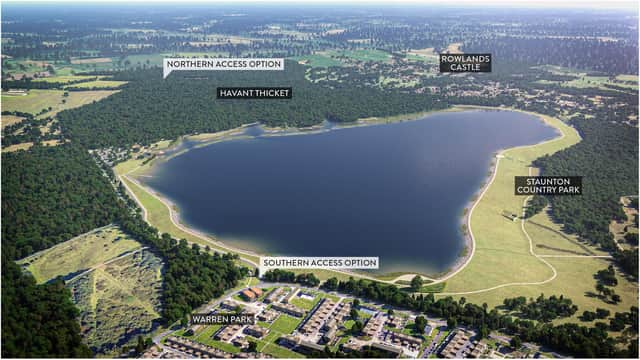

Havant Thicket Reservoir would be built on the grassland site next to Havant Thicket, which sits in between Rowlands Castle, Warren Park, Leigh Park and Staunton Country Park, to the north of Havant.
It would be the first reservoir to be built in the South East since the 1970s and able to supply about 160,000 people.
As well as providing vital supplies for the South East, the reservoir will create an exciting new local leisure facility and wildlife conservation area for nearby communities. It also means less water can be taken from the Rivers Test and Itchen, which will be better for the environment.
Portsmouth Water is sharing its plans during a public consultation until June 8, ahead of submitting a planning application later this year. The Havant-based company is really keen to hear the views of its local communities.
A ‘virtual exhibition' is online here where everyone can find out more, ask questions and share ideas and feedback.
Why do we need a reservoir?
The South East is under ‘serious water stress’ and to keep taps running and protect water levels in rivers, water companies need to find new sources of water.
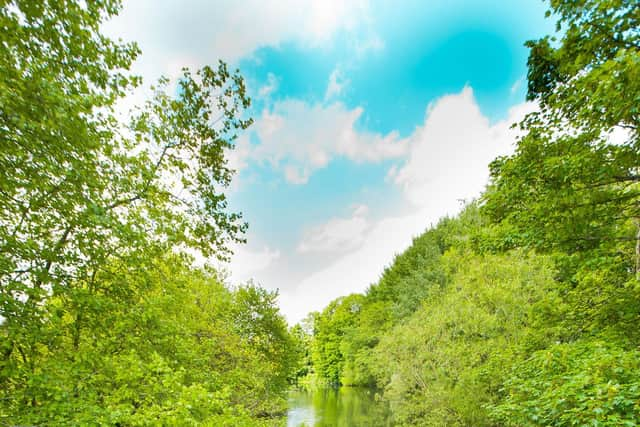

They also need to cater for an increase in housing and population and cope with the effects of climate change. In particular, Southern Water, which supplies water to the west of Hampshire, needs to take much less water from the Rivers Test and Itchen in Hampshire – two internationally-renowned chalk streams – to keep them healthy and protect the wildlife there.
Portsmouth Water plans to build the reservoir and fill it with spare water from springs in Havant, which usually just runs out to sea in winter. This reservoir water would supply customers nearby, which would free up other water in the west for Southern Water to supply to its customers.
Southern Water would pay for the water and this would fund the reservoir, so it won’t increase the bills of Portsmouth Water customers, which are already the lowest in the country.
Building the reservoir
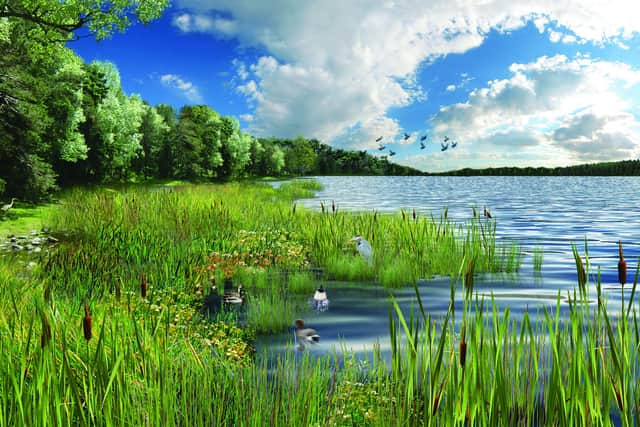

The reservoir would take nine years from today to plan, build and fill with water. It will have embankments on three sides and a wetland along the northern edge, with paths all the way round, a visitor centre, car parks and picnic and play areas.
The site is a natural valley and has lots of clay underground which could be dug up and used to shape the reservoir – it’ll be about a mile long, half-a-mile wide and up to 18 metres deep.
While it’s being built, as much of the open areas and paths would be kept open as possible, while it’s safe to do so. There’ll also be lots opportunities for visits from schools and universities and for apprenticeships and local employment.
During the construction, Portsmouth Water would take measures to reduce the impact on local communities and the environment as much as possible.
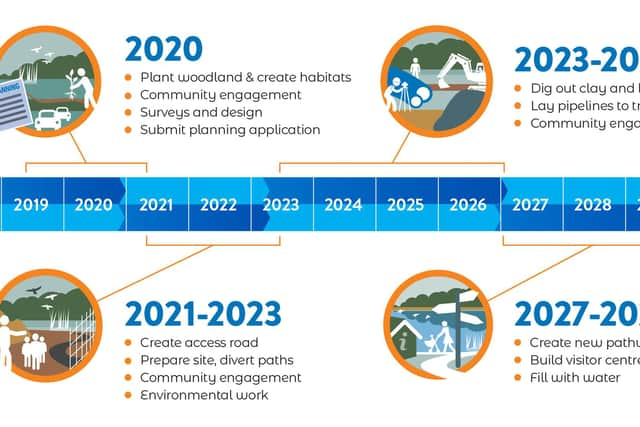

Looking after wildlife and the environment
Care for the environment and wildlife is the most important part of the reservoir plans.
Building it will protect the rare chalk streams, the River Test and River Itchen, and there is an exciting plan to create a large new wetland along the north of the reservoir to offer a home for a wide range of water plants, wetland birds and other wildlife.
There’s also lots of opportunity to plant new woodland, hedgerows, meadow areas and improve local streams, such as the Hermitage Stream.
The plans have been adapted to reduce the loss of trees as far as possible, however some ancient woodland would need to be removed. Portsmouth Water is committed to replanting and improving at least eight times as much woodland as is removed and creating woodland corridors and havens around the reservoir for wildlife to migrate to before construction begins.
The environment will benefit overall from the reservoir being built and there will also be projects to support the environment in other areas and a grant scheme to fund local community projects to benefit wildlife.
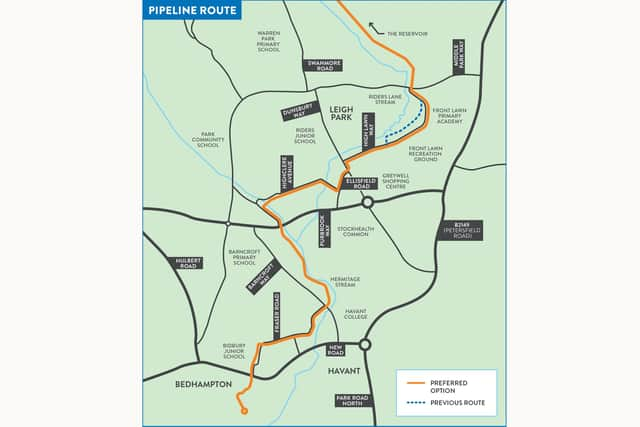

Trevor Codlin, Principal Ecologist at Portsmouth Water, said: “We’re working with organisations like Natural England and the Hampshire and Isle of Wight Wildlife Trust to create the best habitat for wildlife and the best experience for visitors to bring people closer to nature and learn more about what’s on their doorstep.”
Leisure and visitor centre
The reservoir is also a great opportunity to create an exciting new leisure hub in the heart of local communities for people of all ages to stay active and healthy, learn more about water and wildlife and get together as a community.
Based on lots of feedback over the years, the plans include creating a visitor centre next to the water, with a terrace and views across to the wetland, a café, a shop for local produce and an education space, picnic and play areas, bird hides and a 5 km network of trails for walking, cycling and horse riding.
The visitor centre is being designed to fit in with the natural environment and will be made with natural materials, such as wood. It’ll be designed to be as accessible as possible.
There’ll be a car park but everyone will be encouraged where possible to leave their cars at home and visit by public transport, bike or on foot.Portsmouth Water is working with its neighbours at Staunton Country Park (run by Hampshire County Council) and Havant Thicket Woodland (managed by Forestry England) to make sure all the sites can support each other with activities, parking and travel.
Getting to the reservoirA new road is needed so people can get to the reservoir and so it can be built.
For many years the preferred route for the new road was from the north – off the A3(M) at junction 2 and via the B2149 – with the new road running through Havant Thicket woodland. It was supported because it’s close to the A3 and avoids residential areas in Warren Park and Rowlands Castle. There are concerns about more traffic on the B2149.
Changes in recent years, have led to a new option, which could be created instead of, or in addition to, the one from the north. This would come from the south off Swanmore Road, in Warren Park, and run along the side of the reservoir up to the visitor centre.
Simon Hughes, Engagement lead at Portsmouth Water, said: “We’d really like to hear more about what people think about these two options for a new access road. Whichever one we put forward, or if it’s both, we’d make sure we do everything we can to minimise the impact on local communities and the woodland.”
Pipeline
A new pipeline is also needed to fill the reservoir with water and draw it off when it’s needed to supply customers.
Over the next few years more surveys will be carried out and a plan developed with residents and businesses to keep disruption to a minimum.
Join a webinar
Portsmouth Water is running public webinars to share information about the reservoir and give everyone a chance to ask questions. In the webinars, short films are played and the project team are on hand to answer questions typed in by the audience.
There are two more during the consultation: Wednesday 3 June at 2pm and Thursday 4 June at 6pm. Sign up here. Earlier webinars have been recorded and are available on Portsmouth Water’s YouTube channel.
Have your say
There are lots of ways to get involved. Portsmouth Water is keen to hear everyone’s views and ideas during the consultation, which closes on June 8 2020.
Visit the virtual exhibition here, listen to films, post ideas on maps and boards and fill in an online survey. Email here, write to Portsmouth Water, PO Box 99, West Street, Havant, PO9 1LG, call and leave a message on 02392 449084 or connect on Facebook @havantreservoir.
For a printed copy of the consultation brochure please use one of the contact methods above to share your name and address.